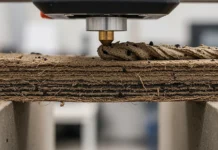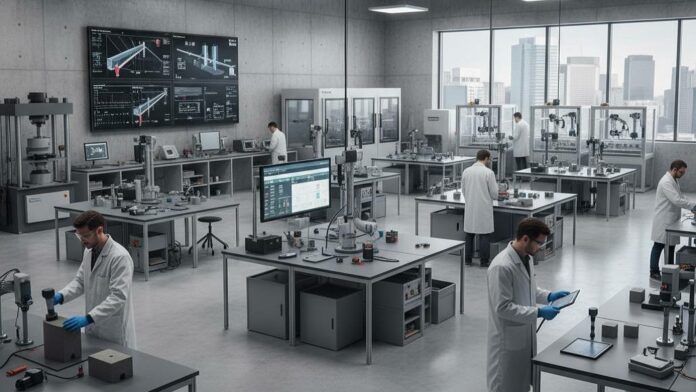Digital Material Testing Advancing Concrete Performance
The construction industry’s relentless pursuit of structural excellence and safety has reached a pivotal moment where traditional material testing methods intersect with cutting-edge digital technologies. Digital material testing in concrete represents a revolutionary approach that transcends conventional laboratory procedures, introducing unprecedented precision, real-time monitoring capabilities, and predictive analytics that fundamentally transform how concrete performance is evaluated, optimized, and validated throughout building lifecycles.
Contemporary construction projects demand materials that meet increasingly stringent performance standards while operating under complex environmental conditions and extended service life requirements. Traditional testing methods, while foundational to concrete technology development, often provide limited insight into long-term performance characteristics and real-world behavior under dynamic loading conditions. Digital material testing systems address these limitations by providing comprehensive, continuous monitoring capabilities that capture material behavior across multiple performance dimensions simultaneously.
The integration of artificial intelligence, advanced sensor technologies, and cloud-based analytics platforms creates testing ecosystems that deliver insights previously unattainable through conventional approaches. These systems not only verify compliance with established standards but also generate predictive models that forecast material performance under various scenarios, enabling proactive optimization strategies that enhance both safety and economic outcomes.
Advanced Concrete Testing Methodologies
Digital transformation in concrete testing encompasses sophisticated methodologies that leverage multiple sensor types, data fusion techniques, and analytical algorithms to create comprehensive material characterization profiles. Non-destructive testing technologies now provide detailed internal structure analysis without compromising sample integrity, enabling continuous monitoring throughout material lifespans.
Ultrasonic testing systems utilize high-frequency sound waves to detect internal discontinuities, measure elastic properties, and assess concrete homogeneity with remarkable precision. Advanced ultrasonic arrays can create three-dimensional images of concrete internal structure, revealing aggregate distribution patterns, void locations, and potential crack initiation sites that would be impossible to detect through traditional testing methods.
Ground-penetrating radar technology provides non-invasive assessment of concrete structure depth, reinforcement placement accuracy, and moisture content distribution. These systems can rapidly scan large concrete areas, generating detailed subsurface maps that guide maintenance planning and structural assessment decisions while eliminating the need for destructive core sampling in many applications.
Electromagnetic induction testing offers precise measurement of concrete electrical properties, which correlate strongly with moisture content, chloride concentration, and carbonation depth. These parameters serve as crucial indicators of long-term durability performance, enabling early detection of degradation processes before visible damage occurs.
Digital Sensors Revolutionizing Quality Control
The deployment of embedded digital sensors within concrete structures creates permanent monitoring networks that provide continuous performance data throughout building lifespans. These sensor networks generate vast quantities of real-time information about stress distribution, temperature cycles, moisture fluctuations, and structural response characteristics under varying load conditions.
Strain gauge networks embedded during concrete placement provide precise measurement of structural deformation patterns, enabling validation of design assumptions and identification of unexpected loading conditions. Advanced strain sensing systems can detect microscopic deformations that precede visible cracking, providing early warning capabilities that enhance structural safety and enable proactive maintenance interventions.
Temperature monitoring systems track concrete curing processes with unprecedented detail, enabling optimization of strength development and minimization of thermal stress-related cracking. Multi-point temperature sensors can identify hot spots, monitor curing uniformity, and validate thermal modeling predictions used in massive concrete construction projects.
Corrosion monitoring sensors embedded near reinforcing steel provide continuous assessment of electrochemical conditions that influence reinforcement durability. These systems can detect the onset of corrosion processes years before visual evidence appears, enabling timely protective interventions that extend structural service life significantly.
Wireless sensor networks eliminate the need for extensive cabling while providing flexible deployment options that adapt to diverse construction geometries. Low-power wireless technologies enable sensor networks to operate for extended periods without maintenance, creating permanent monitoring capabilities that provide value throughout building lifecycles.
AI Quality Control Systems Transforming Testing Protocols
Artificial intelligence integration in concrete testing systems creates analytical capabilities that surpass human interpretation capacity while providing consistent, objective evaluation criteria. Machine learning algorithms trained on extensive concrete performance databases can identify patterns and correlations that would be impossible to detect through traditional analytical approaches.
Computer vision systems analyze concrete surface characteristics, aggregate distribution patterns, and microstructural features with precision that exceeds human visual assessment capabilities. These systems can automatically identify potential quality issues, classify defect types, and recommend corrective actions based on learned patterns from similar conditions.
Predictive analytics algorithms utilize historical performance data, environmental conditions, and material properties to forecast long-term behavior characteristics with remarkable accuracy. These predictions enable optimization of material formulations, construction procedures, and maintenance strategies based on projected performance outcomes rather than reactive responses to observed problems.
Real-time quality control systems integrate multiple sensor inputs with artificial intelligence analysis to provide immediate feedback during concrete production and placement operations. These systems can detect quality deviations as they occur, enabling immediate corrective actions that prevent defective material from being incorporated into structures.
Smart Testing Infrastructure and Implementation
Smart testing laboratories incorporate automated testing equipment, robotic sample handling systems, and integrated data management platforms that dramatically improve testing efficiency while reducing human error potential. These facilities can operate continuously, processing large numbers of samples while maintaining consistent testing procedures and documentation standards.
Automated compression testing machines equipped with digital load cells, displacement sensors, and data logging capabilities provide precise strength measurements while eliminating operator variability that can influence test results. These systems can execute standardized testing protocols with exceptional consistency while generating comprehensive datasets for statistical analysis.
Environmental simulation chambers enable accelerated testing under controlled temperature, humidity, and atmospheric conditions that simulate long-term exposure scenarios in compressed timeframes. These systems can replicate decades of environmental exposure in months, providing insights into long-term performance characteristics that inform material optimization strategies.
Data integration platforms consolidate information from multiple testing systems, creating centralized databases that enable comprehensive analysis across projects, materials, and environmental conditions. These platforms support advanced analytics applications while ensuring data quality and traceability throughout testing processes.
Construction Materials Intelligence and Analytics
Digital material testing generates unprecedented volumes of performance data that require sophisticated analytical approaches to extract meaningful insights for construction decision-making. Advanced analytics platforms process these datasets to identify optimization opportunities, predict performance outcomes, and guide material selection decisions.
Material property databases enriched with testing data from digital systems enable statistical analysis of performance trends, identification of optimal material formulations, and development of performance prediction models. These databases support evidence-based decision-making while providing benchmarking capabilities for new material developments.
Comparative analysis tools enable evaluation of different concrete formulations, construction techniques, and environmental conditions to identify factors that optimize performance outcomes. These tools support continuous improvement initiatives while providing objective criteria for material selection and construction procedure optimization.
Performance trending analysis identifies gradual changes in material characteristics that may indicate emerging quality issues or opportunities for process improvement. Early detection of performance trends enables proactive interventions that maintain quality standards while minimizing costs associated with corrective actions.
Future Directions and Technological Integration
The convergence of digital material testing with emerging technologies promises even greater capabilities for concrete performance optimization and quality assurance. Blockchain technology can provide immutable testing records that ensure data integrity while enabling transparent quality verification processes across construction supply chains.
Internet of Things integration creates seamless connectivity between testing systems, construction equipment, and project management platforms, enabling real-time coordination of testing activities with construction schedules and quality control procedures. This connectivity supports just-in-time testing strategies that optimize resource utilization while maintaining quality standards.
Augmented reality applications can overlay digital testing data onto physical structures, providing construction professionals with immediate access to material performance information during construction and maintenance activities. These visualization tools enhance decision-making capabilities while improving communication between technical specialists and field personnel.
Digital twin technologies create virtual replicas of concrete structures that incorporate real-time performance data from embedded sensors and testing systems. These digital representations enable simulation of various scenarios, optimization of maintenance strategies, and prediction of long-term performance outcomes with unprecedented accuracy.
Conclusion
Digital material testing represents a fundamental transformation in how concrete performance is evaluated, monitored, and optimized throughout construction project lifecycles. By integrating advanced sensor technologies, artificial intelligence analytics, and comprehensive data management systems, these approaches provide insights and capabilities that were previously unattainable through conventional testing methods.
The successful implementation of digital material testing requires coordination between testing professionals, construction teams, and technology specialists supported by comprehensive training programs and standardized procedures. However, the benefits of enhanced quality assurance, improved performance prediction, and optimized material utilization justify the investment required for successful adoption.
As construction projects become more complex and performance requirements continue increasing, digital material testing provides essential tools for meeting these challenges while maintaining safety standards and economic viability. The continued evolution of these technologies will play a crucial role in advancing concrete technology and construction quality for future infrastructure development.































